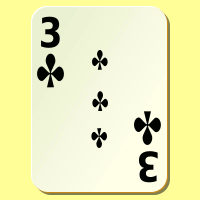By Michael Hartley
Have you ever heard of the card game "Cassino"? That's Cassino, not Casino. I got a nice email the other day from a fellow called Marsh Kaminsky, explaining how he used a variant of Cassino, which he called Mathino to teach his pre-school kids to love math!
For those who don't know the rules of Cassino, they're quite simple, and will definately give keen young players a lot of practice with their basic arithmetic. Here they are. Two (usually) or up to five players play at a time, and you can play with an ordinary pack of playing cards.
- The dealer deals four cards to each player, then four cards face up on the table.
- On a player's turn, they can either
- Take one of the face-up cards, using a matching card in his or her hand. For example, if there was a 2 face up on the table, a player with a 2 in their hand could take the 2 from the table, and the 2 from their hand, and keep them aside.
- Or (This is where the math comes in) Take two or more of the face-up cards, using a card that equals their sum. So if there was a 2 and a 5 on the table, a player with a 7 could take both cards and keep them aside.
- Or, a player can build a card on the table, by adding a card from their hand. However, they can only do this if the sum of the two cards equals a card in their hand. So for example, if there was a 3 on the table, a player with a 5 and an 8 could place the 5 with the 3, and announce that it's been built into an 8. Of course, the idea is to take the "build" next round, but there's the danger that the build might be snatched - or built further - by another player.
- If all else fails, the player can discard one card onto the table.
- So, after each turn, the player has one less card in his or her hand.
- After all players have run out of cards, you can keep score. The proper scoring system is a little complex. For a young kid, it's probably enough just to count who has the most cards, and let that be the score. If you are interested to see the proper scoring system, check out the wikipedia article on the game.
If you have a young kid, you might prefer to discard the picture cards, to make the rules simpler. Maybe even start with just rules 1 and 4. And when they are used to that, introduce rule 2, then later rule 3. Then your youngster will be getting lots of practice with addition.
Some more tips
- Be patient with your kid as he or she plans what card to play next. Remember, they're practicing their sums - and think it's just fun!
- Give encouragement when he or she wins - or loses... Make it fun, and they'll keep wanting more!
- If your child is counting the pips on the cards, and you feel it's time to move to addition proper, maybe switch to Uno cards instead (make the 0's count as 10's).
Well, even plain vanilla Cassino can be a valuable "addition" (pardon the pun!) to your toolbox for teaching kids math. But Marsh Kaminsky's "Mathino" is a stroke of genius. Basically, instead of just using addition to build and take cards, he gradually introduced his kids to new rules : first subtraction, and later multiplication. The kids didn't know they were learning schoolbook stuff. For them, it was just new rules for a fun game!
- Subtraction is an easy enough rule to work into the game. For example, if the cards 5 and 3 are on the table, they could be taken by a player with an 8 in their hand (as per the normal rule 2, because 3 plus 5 is 8), or also by a player with a 2 in their hand (because 5 minus 3 is 2). Or if there was a 1, a 3 and a 5, players could have any of 5+3+1, 5+3-1, 5-3+1 or even 5-3-1 and be able to snatch them all up!
- Multiplication is more difficult, since many multiplication sums give result above 10. Marsh Kaminsky suggests this rule :
- After doing a multiplication, if the answer is more than 10, add the digits up to see what card the player needs to make the match. So two eights would "equal" 10, since, 8 times 8 is 64, and 6+4 is 10. Or a 7 and an 8 would be 2, because 7 times 8 is 56, 5 plus 6 is 11, and 1+1 is 2.
Marsh - and his kid's teachers - saw great results!
Ever since I got his email about Mathino, I've been looking forward to trying it with my own 6-year-old son. I'll move straight on to Uno cards, so he doesn't just count the dots... But I thought his idea too good to wait before I shared it on this site. I hope it works wonders for your children too!
Yours, Dr Mike...
